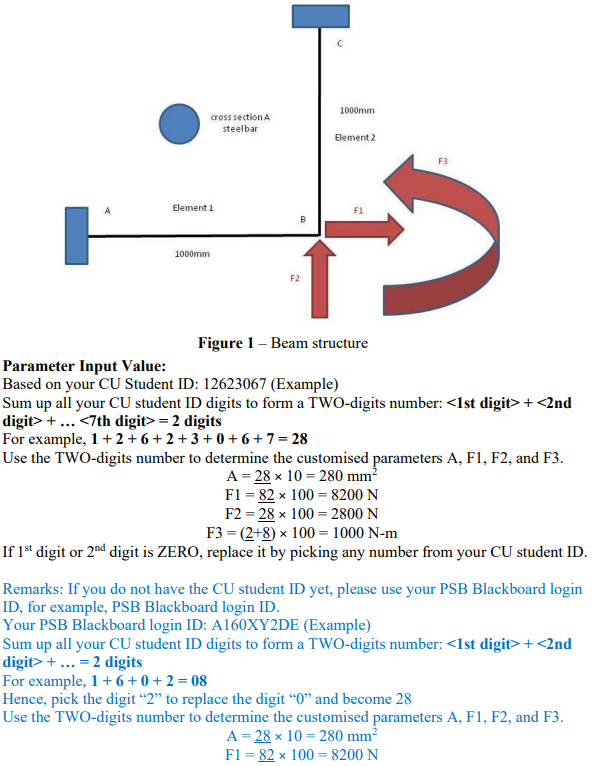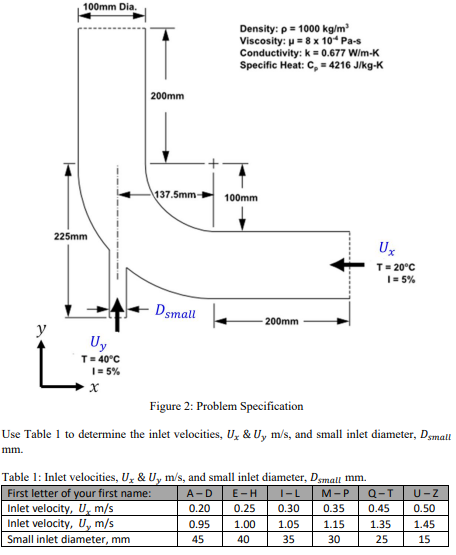| Category | Case Study | Subject | Engineering |
|---|---|---|---|
| University | Coventry University | Module Title | PSB501EN Mechanical Engineering Systems |
The solution for “real world” technical engineering problems requires an exercise of interpretation and the adoption of a multi-technique approach to provide adequate outputs to the complexity of the challenges. Assessment 1 seeks to reproduce such challenges through a combined analytical, numerical, and interpretive approach to various scenarios.
Case Study: engineering problems requiring analytical or numerical (simulation) solution (1500 words or equivalent).
Students are required to complete three case studies. All questions within a case study must be answered and submitted as a written report.
Instruction:
Answer all Case studies. Each case study carries different marks, but the total marks for the coursework are 100 marks.
All solutions should be typed. Marks are not awarded for handwritten work.
This is an open-book, take-home assignment; you are allowed to use all resources available to you. All references used need to be appropriately cited. APA style (7th edition) reference formatting. You may refer to the CU library guides at https://libguides.coventry.ac.uk/apa
In a case study, some questions may be a continuation of the preceding question.
Academic Integrity Guidance
The best way to avoid academic misconduct is to follow appropriate academic and referencing conventions. Collusion between students (where sections of your work are similar to the work submitted by other students in this or previous module cohorts) is taken extremely seriously and will be reported to the Academic Conduct Panel. This applies to all coursework and exam answers.
If you would like more guidance on understanding collusion, you can find it on LibGuides. If an assessment suspected of involving a breach of academic integrity is found to display a marked difference in writing style, knowledge and skill level from that demonstrated elsewhere on the course, you may be required to undertake a Viva Voce to prove the coursework
assessment is entirely your work.
You must not submit work for an assessment that you have already submitted (partially or in full), either for your current course or for another qualification of this university, unless this is specifically provided for in your assessment brief or specific course or module information.
It is important to realise that as a student, you should not submit all or part of an assessment for which you have already received academic credit to be used for an assessment in a different module. Reusing your work in this way is called self-plagiarism. Where you wish to refer to some of your work, you must reference it in the same way that you reference work by other people.
Struggling to complete this Assignment and feeling stressed? Take our Assignment Writing Services
Buy AssignmentHired as a structural integrity engineer, you are tasked to perform the analytical study on the beam structure shown in Figure 1. Each element’s length is 1000 mm, and the Young's modulus of Elasticity is 210 GPa.

I) Model the given beam structure with the input parameters based on your student ID. Including:
a. Create elements and FEA model in computer Simulation Software.
b. Apply the Loads and Boundary conditions at nodes.
c. Run the Computer Simulation FEA solver and examine the Simulation FEA
Results.
II) Analyse and comment the FEA results
Note: If you submit Simulation generated report, you will receive a ZERO mark.
Assumed Knowledge:
Completed the tutorial 1 – Introduction to Using ANSYS Fluent in ANSYS
Workbench: Fluid Flow and Heat Transfer in a Mixing Elbow.
Assignment Description:
You are required to perform geometry creation and meshing on a computational domain for fluid flow and heat transfer in a mixing elbow base on the given problem description and perform the three-dimensional computational simulation. You must generate TWO different types of mesh and then perform a mesh quality comparison between them.
Report format for case study 2:
2.1 Introduction
2.2 Methodology
2.3 Results
2.4 Conclusions
2.5 Reference
Problem Description:
The problem to be considered is shown schematically in Figure 2. A cold fluid at 293.15 K flows into the pipe through a large inlet and mixes with a warmer fluid at 313.15 K that enters through a smaller inlet located at the elbow. The mixing elbow configuration is encountered in piping systems in power plants and process industries.
It is often important to predict the flow field and temperature field in the area of the mixing region in order to design the junction.

Submit Your Assignment Questions & Get Plagiarism-Free Answers.
Order Non-Plagiarized AssignmentI) Many damped physical systems found in engineering may have their behaviour expressed by second-order non-homogeneous ordinary differential equations (ODEs). This type of problem involves obtaining the response of the associated homogeneous ODE and a particular solution of the non-homogeneous ODE.
The sum of these two provides the general solution of the non-homogeneous ODE. Based on this information, what is the physical meaning of the solution of the associated homogeneous ODE?
II) Vibrations in rotating machinery, such as turbines, engines, and motors, can
significantly impact performance, reliability, and maintenance schedules. Engineers analyse vibration characteristics to prevent resonance, reduce wear, and enhance operational stability.
A rotor system in a turbine is modelled as a single-degree-of-freedom (SDOF) system, consisting of a 4 kg disk mounted on a shaft with an effective stiffness of 36 N/m. The system is undamped and subjected to an external harmonic excitation force given by: 𝐹(𝑡) = 15 cos(3𝑡) 𝑁.
a. Determine the natural frequency of the system in Hertz.
b. Calculate the steady-state amplitude of vibration when the system is subjected to the external force 𝐹(𝑡).
c. If the shaft is redesigned to have a new stiffness of 64 N/m, discuss how the
vibration response would change and its implications for machine operation?
d. In real-world applications, damping is often introduced to mechanical systems. Discuss how adding damping would affect the system’s vibration behavior. What are some practical methods used to reduce excessive vibrations in rotating machinery?
Note: The consultation of support materials (books, journal papers, conference papers, industrial technical reports, etc.) is strongly encouraged and must follow the guidelines for academic citation.
Seeking with your PSB501EN Mechanical Engineering Systems, to now stress free and get Professional Help With Engineering Assignment from our expert team. We also provide free case study samples that have been written by PhD expert writers. We are available 24/7 to assist you. Now, be tension-free and focus on studying and give your assignment to our expert team. We will deliver your assignment before the deadline with well-researched results. Contact us today and boost your academic grades!
Hire Assignment Helper Today!
Let's Book Your Work with Our Expert and Get High-Quality Content
